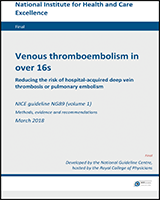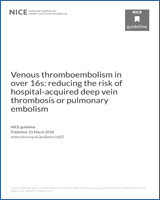NCBI Bookshelf. A service of the National Library of Medicine, National Institutes of Health.
National Guideline Centre (UK). Venous thromboembolism in over 16s: Reducing the risk of hospital-acquired deep vein thrombosis or pulmonary embolism. London: National Institute for Health and Care Excellence (NICE); 2018 Mar. (NICE Guideline, No. 89.)
December 2019: In recommendation 1.3.5 the British Standards for anti-embolism hosiery were updated because BS 6612 and BS 7672 have been withdrawn. August 2019: Recommendation 1.12.11 (1.5.30 in this document) was amended to clarify when anti-embolism stockings can be used for VTE prophylaxis for people with spinal injury.

Venous thromboembolism in over 16s: Reducing the risk of hospital-acquired deep vein thrombosis or pulmonary embolism.
Show details38.1. Introduction
Thoracic surgery involves the repair of organs located in the thorax, or chest. Factors that may alter the risk of VTE in people undergoing thoracic surgery:
- After lung resection, pulmonary embolism to the remaining lung carries a commensurately higher risk of death.
- Most patients who have video-assisted thorascopic surgery (VATS), particularly for pneumothorax, are young (less than 30 years) and are able to walk around the ward up to the time of surgery and soon after and have short lengths of stay.
There are no special factors that increase the risk of bleeding or the hazard associated with it in thoracic surgery. There are no other special factors that would affect the choice of, and use of, specific methods of VTE prophylaxis in thoracic surgery.
38.2. Review question: What is the effectiveness of different pharmacological and mechanical prophylaxis strategies (alone or in combination) for people undergoing thoracic surgery?
For full details see review protocol in appendix C.
Table 222
PICO characteristics of review question.
38.3. Clinical evidence
No relevant clinical studies comparing different pharmacological and mechanical prophylaxis strategies for people undergoing thoracic surgery were identified. Papers included in the previous guideline (CG92) in the major surgery review were considered for inclusion in addition to papers identified in the update.
38.4. Economic evidence
Published literature
One health economic study was identified with the relevant comparison and has been included in this review.305 This is summarised in the health economic evidence profile below (Table 223) and the health economic evidence tables in appendix J.
See also the health economic study selection flow chart in appendix F.
Table 223
Health economic evidence profile: LMWH (standard dose, standard duration) + AES (knee-length) vs LMWH (standard dose, standard duration) + AEs (thigh-length) vs LMWH (standard dose, standard duration).
38.5. Evidence statements
Clinical
No relevant clinical studies were identified.
Economic
- One cost-utility analysis found that for VTE prophylaxis in high risk general surgery patients, LMWH (standard dose, standard duration) + thigh-length AES was dominant (less costly and more effective) compared to LMWH (standard dose, standard duration) alone and to LMWH (standard dose, standard duration)+ AES (knee-length). This analysis was assessed as partially applicable with potentially serious limitations.
38.6. Recommendations and link to evidence
| Recommendations |
|
| Research recommendation | None |
| Relative values of different outcomes |
The committee considered all-cause mortality (up to 90 days from hospital discharge), deep vein thrombosis (symptomatic and asymptomatic) (7–90 days from hospital discharge), pulmonary embolism (7–90 days from hospital discharge), major bleeding (up to 45 days from hospital discharge) and fatal PE (7–90 days from hospital discharge) as critical outcomes. The committee considered health-related quality of life (up to 90 days from hospital discharge), clinically relevant non-major bleeding (up to 45 days from hospital discharge), heparin-induced thrombocytopaenia (duration of study) and technical complications of mechanical interventions (duration of study) as important outcomes. Please see section 4.4.3 in the methods chapter for further detail on prioritisation of the critical outcomes. |
| Quality of the clinical evidence | No clinical evidence was identified for this review. |
| Trade-off between clinical benefits and harms |
In the previous guideline this group was considered together with other major abdominal surgery (gastrointestinal, bariatric, gynaecological, urological). For the update the committee wished to explore if there was any evidence specifically for the thoracic surgery population because it was considered to be different clinically to the abdominal surgery population both in terms of the procedures involved and the fact that the chest and not the abdomen or pelvis that was being operated on. In the absence of direct evidence the committee considered it would be reasonable to extrapolate the recommendations from the abdominal surgery population to this population, including the strength of the recommendation as this is a high risk group. However the use of fondaparinux sodium in the thoracic surgery population is off-label as fondaparinux sodium did not have a UK marketing authorisation for this indication at the time of consultation (October 2017). Therefore the committee recommend LMWH in the first instance and fondaparinux sodium only if LMWH is contraindicated. Following lung resection, the risk of PE in the remaining lung is higher. Some patients having certain types of thoracic surgery (for example video-assisted thorascopic surgery) are younger, are mobile up to the time of surgery and soon after. Mechanical prophylaxis is recommended until the patient is back to normal mobility as the committee believe that mechanical prophylaxis offers little benefit once a patient is mobile. Pharmacological prophylaxis is recommended for a minimum of 7 days because the average duration of trials extrapolated from the abdominal surgery was between 7 and 10 days. |
| Trade-off between net clinical effects and costs |
No economic studies were identified to specifically cover thoracic surgery patients; however, one economic study that has been included in the major abdominal surgery review covered the general surgical population stratified according to the risk of VTE. The committee considered that this evidence can be applicable to the thoracic surgery population, specifically the “high risk” subgroup. The study is a cost-utility analysis for standard duration prophylaxis. It was assessed as partially applicable with potentially serious limitations. This analysis showed that combined prophylaxis using LMWH + AES (thigh length) was dominant (more effective and less costly) compared to single prophylaxis with LMWH only (standard dose, standard duration) only and combined prophylaxis of LMWH (standard dose, standard duration)+ AES (knee-length). The committee discussed whether the evidence was enough to recommended either knee or thigh length AES. The economic evidence supported the cost effectiveness of combined prophylaxis that includes thigh-length AES, however the committee noted that thigh-length AES are less convenient for people to wear and are more difficult to fit. Hence, the committee agreed that the choice of the length of stocking should be made taking into account the preference of the individual and his/her ability to adhere to wearing them. IPCD was also recommended as an alternative option that requires less nursing time in terms of fitting and monitoring. The committee also agreed that both LMWH and fondaparinux should be recommended as pharmacological options to address issues of contraindications and individual preferences. As fondaparinux use in this population is off-licence it should only be considered where LMWH is contraindicated. |
| Other considerations | The ‘consider’ recommendation is a reflection of the lack of evidence in this population. However, it is the committee’s view that for this group of patients, prophylaxis is likely to be most clinically and cost effective for those assessed to be at high risk of VTE. |
Footnotes
- hh
At the time of publication (March 2018), LMWH did not have a UK marketing authorisation for use in young people under 18 for this indication. The prescriber should follow relevant professional guidance, taking full responsibility for the decision. Informed consent should be obtained and documented. See the General Medical Council’s Prescribing guidance: prescribing unlicensed medicines for further information.
- ii
At the time of publication (March 2018), LMWH did not have a UK marketing authorisation for use in young people under 18 for this indication. The prescriber should follow relevant professional guidance, taking full responsibility for the decision. Informed consent should be obtained and documented. See the General Medical Council’s Prescribing guidance: prescribing unlicensed medicines for further information.
- jj
At the time of publication (March 2018), fondaparinux sodium did not have a UK marketing authorisation for this indication. The prescriber should follow relevant professional guidance, taking full responsibility for the decision. Informed consent should be obtained and documented. See the General Medical Council’s Prescribing guidance: prescribing unlicensed medicines for further information.
- Thoracic surgery - Venous thromboembolism in over 16sThoracic surgery - Venous thromboembolism in over 16s
Your browsing activity is empty.
Activity recording is turned off.
See more...
